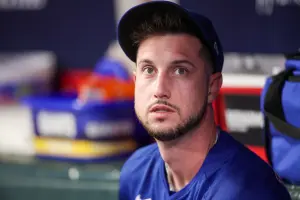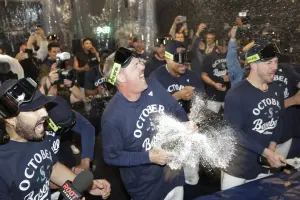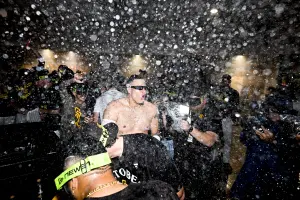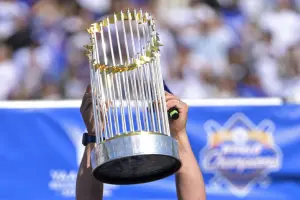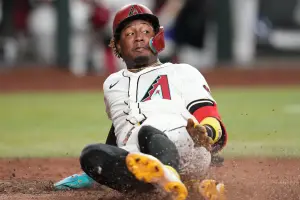
(*) GM's OFFICE: Shredded plans, mulligans & QBaB—2021 FSGA draft review
The FSGA draft, held Monday night, reinforced the idea that even if you have a detailed plan heading into a draft, knowing the player pool and being flexible are two paramount qualities for a successful event. Even when the curveballs surface right at the top.
To refresh the details of our anticipated selections at 6pm Monday, see our draft preview article here. But here’s the short version:
Ray and I were slotted at the wheel of this 14-team draft. Using a mix of ADP and RotoLab values, we identified a safe bundle of SP2s that would likely be still on the board at our Rd 5/6 turn. Though there was a temptation to double-tap starters with our first two picks, we decided to instead just grab one top starter in that turn, focus on offense in Rds 3/4, and then hitch ourselves to a Ryu/Hendricks/Berríos type with one of our Rd 5/6 picks. That would net us four hitters and two solid starters through the first six rounds.
Which in hindsight, is exactly how our roster looked after six—but the composition of the players was quite, quite different than we expected. For reference, it may be helpful to follow along using the entire draft board found at this link.
In-depth details to give you an edge, every day from spring training through season’s final pitch. Subscribe to BaseballHQ.com. Winning. Fantasy Baseball. Insight.
Here were three specific times early on in the draft where we felt we needed to pivot:
First, we figured (wrongly) that overall the first 13 picks would follow ADP closely, even if the order was skewed a bit. We planned on our pick 1/2 hitter being one of the Freeman/Harper/Bellinger trio, and our pitcher likely either Bauer or Buehler—whom Ray and I both like a half-tick above the Darvish/Giolito/Nola group. When Bauer went at #11, we (rightly) assumed that Buehler would be available at our turn. What we did not anticipate on the hitter side was that Trevor Story—who does not have the same pure hit + power skills as Freeman, but does have an envious power/speed combination—would still be on the board. With the global SB situation in decline, it didn’t take much discussion to nab Story in with pick 1, and then Buehler with pick 2.
Second, we figured (wrongly) that there was a good chance that a top third baseman would be around when the board got to our round 3/4 position: Devers, Bregman and Rendon are back-to-back-to back in ADP right in that same pick area. Of course, all three were snatched up in round three before our pick, so more of power + BA guys were gone. But in a case like that, someone has to fall, and that main someone was Tim Anderson. While we had some discussion on whether to make both of our top two picks shortstops (thus needing to keep one eye on positional concerns as the draft went on), in just about every other sense, this was a positive. Another chunk of steals. Mid-range power. And perhaps biggest, a nice add to our BA foundation. So, Anderson it was.
Third, we figured (wrongly) that given how starting pitching has flown off of many a draft board in the second rounds (see Ryan Bloomfield’s LABR recap from last week), there wouldn’t be any pitcher we were really interested in, factoring in risk, at the end of round 3. But a few picks before that 3/4 turn, Ray or I mentioned that Brandon Woodruff was still out there. With an ADP of 30, Woodruff had fallen almost an entire round when, indeed, he was still available when we picked at number 42. This was a discussion to have; something so outside what we expected when we were mapping out our plans. As the writer of his 2021 Baseball Forecaster box, I had pretty much only positive vibes. He’s 28, just about all his skills are on the rise, and he could be a 200-K pitcher. Taking him would obviously switch up our finely-tuned plan … but when faced with the chance of coming away with Story/Buehler/Anderson/Woodruff as our top four picks, we decided we couldn’t pass it up.
Four rounds in, and our blueprint was off to the shredder. These things happen.
***
Though only partially by design, there were two other themes that ran through the rest of our draft. I’ll briefly cover them here.
The Dreaded Mulligan
It’s helpful to keep in mind that no one has any idea how the wacky 2020 season will affect players in 2021. In our community—here at BaseballHQ.com, but even more broadly in our friends/competitors in the industry—warnings occur often of the pitfalls of “recency bias." The idea is that a player’s latest (or most recent) performance is overemphasized, which can drive player value up or down disproportionally to their history, raw skill set, or other factors. In other words: taking the short view, rather than the long view. And this was BEFORE all the disruption, small samples, COVID restrictions, and everything else that 2020 brought forth. We all (points to self) KNOW to be wary of recency bias, but it still ends up creeping into our evaluations.
In our pre-draft discussions, Ray and I talked about the group of players with much higher ADPs in 2020 than 2021—players who underperformed drastically in the short season and thus were paying the ADP price now. What if, as Ron Shandler suggested in the Baseball Forecaster’s introduction, we “threw out” 2020 numbers, and gave more weight to our (and the community’s) evaluations a year ago? Had THAT much changed about a player over 60 games? In a season in which players started spring training, stopped spring training, re-started spring training, dealt with the stresses of a global pandemic, etc, just how much weight should the 2020 stats have on 2021?
I even went back and fired up a 2020 version of RotoLab with the (full season) March projections, and had that on hand during this draft just for comparison purposes. In that light—weighing our 2020 projections just as much as our 2021 projections—we felt we may have selected some players who others have undervalued too much in 2021. Of course, not all of these will hit, but here’s a handful of players we acquired who have serious rebound potential (round acquired in parentheses):
Austin Meadows (8)
Patrick Corbin (9)
Mitch Garver (13)
Joey Gallo (14)
Héctor Neris (20)
Danny Jansen (21)
Michael Kopech (24)*
*Kopech of course didn’t have a “down” 2020, he had no 2020, as he elected to sit out the season.
Other guys on our radar, who didn’t end up on our roster (our frustrated outbursts when these guys went off the board may have been audible) included JD Martinez, Kris Bryant, and Jesús Luzardo.
We’ll see where it goes, but mixing in some of these types of players throughout your drafts could be beneficial.
Taking QBaB out for a spin
And finally, a phrase from Arik Florimonte’s Facts/Flukes column on Monday (the day of the draft) sent me down an 11th-hour rabbit hole that I’ll be watching with interest through the season. Arik is of course the architect for our year-old Quality of Batted Balls metric, or QBaB, that debuted here last winter and then appeared as an essay and in the player boxes of the Baseball Forecaster. In his write-up on Elvis Andrus on Monday, Arik pointed to a QBaB finding; specifically that “a low LA variation … tends to help BA.” The LA (or launch angle) variation is the third character in a player’s QBaB score; the one in lower-case text. Like the other elements, this variation is given an “a” to “f” score—the higher the score, the lower the LA variation. Given that Arik showed how “sticky” these QBaB characteristics are from year to year, we’re fairly certain they are repeatable.
Now of course in working with Arik and digesting his findings over the past year, I knew this correlation—but had not thought about how I might use it during draft season. Long story short, I spent some time the day of the draft noting players from 2020 who registered as “a” or “b” in LA variation, and had those in mind as we discussed possible picks at various stages of the draft. (Ray likely got tired of me saying, “And he’s on our list.”)
Players that we rostered with “a” scores: Anderson, Castellanos, Turner, and Reyes; D. Smith registered a “b”; and Jeff McNeil was a “c,” but had an “a” in 2019.
The caveat, of course, is that for many of these, we liked the hit tool/BA potential already, and/or they may well have been the best players on the board at the time. But even outside that chicken/egg problem, it will be interesting to see how this team—and these players specifically—perform in batting average overall. This tidbit is nothing to drive your whole player selection process, but yet one more nugget to add into the mix.
We think this is a fun team overall—we’ll have to keep on our toes for saves, and in the end our starters could be a bit light. But we’ve had success finding useful pieces in-season before in this league, and feel our offense is ready to go toe-to-toe with anyone. Now the wait until Opening Day arrives.
Feel free to leave comments/questions/observations on our squad below.


